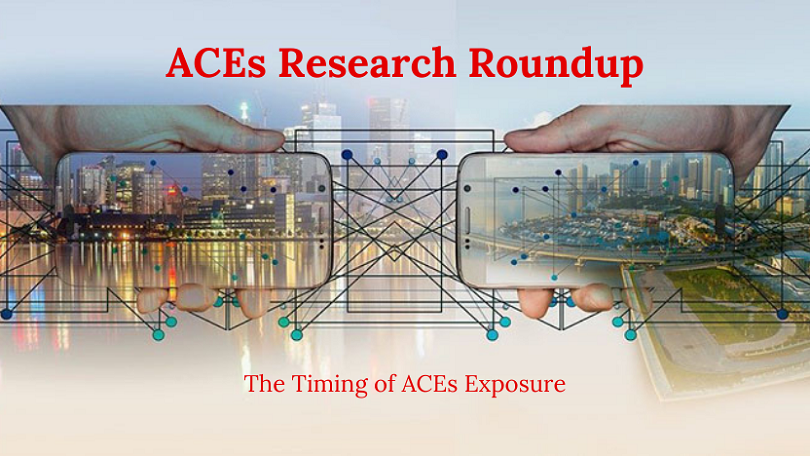Research Roundup May 2021: The Timing of ACEs Exposure
Our monthly column highlights recent studies of Adverse Childhood Experiences (ACEs): causes, consequences, and the interventions that work.
It is well established that Adverse Childhood Experiences are associated with poor outcomes across the life course, including poor physical and mental health, risk-taking behaviors, and lower socioeconomic attainment.1 Last month, we discussed several studies that examined whether different ACEs can be grouped in meaningful ways and whether different ACE exposures are associated with different risks in later life. This month, we will discuss a related issue: whether the timing of ACEs exposure matters and how. The original ACE study2 surveyed 14,000 adults in the United States about their experiences of abuse and/or childhood dysfunction before the age of 18. Participants were asked to report whether they had experienced a battery of items “during [their] first 18 years of life.” However, the first 18 years of life include a wide range of developmental periods, from infancy and early childhood through adolescence. It is reasonable, then, to ask whether asking about one’s experience over a long period of time might mask important differences in the impacts of ACEs on children at different stages of development.Timing-specific effects of ACEs: evidence regarding brain development and outcomes in early adulthood
In a 2019 study by Luben and colleagues,3 the authors collected four waves of behavioral and neuroimaging assessments from 211 children and their caregivers in the St. Louis area over a period of 15 years. In addition to asking about adverse childhood experiences and caregiver support, developmental trajectories in several areas of the brain were observed. The authors found unique patterns of association between ACE experiences and brain development, particularly during early childhood. These findings are important as they shed light on how and when adverse experiences in childhood may “get under the skin” and change developmental trajectories. Moreover, these findings help identify developmental stages during which it may be most important to intervene to prevent or mitigate the impacts of ACE exposure. However, others have cautioned against focusing on early life experiences at the expense of other developmental periods that may also prove important. In a study earlier this year, Andersen and colleagues used Danish whole-population register data to examine associations between timing of exposure to household dysfunction, one of the main constructs captured in the ACE questionnaire, and outcomes in young adulthood such as mental health diagnoses, justice system contact, and poor educational and employment outcomes.4 Consistent with previous research, the authors found that Household Dysfunction Items (HDIs) were associated with poor outcomes in a dose-response fashion; that is, the risk increased with the number of HDIs. Further, the authors found that associations between HDIs and poor outcomes were, in fact, significantly larger for adolescents than for children. These results support the idea that there are age-specific effects of ACE exposure timing—and that these relationships warrant further study.The Adverse Life Experience Scale and the timing of Adverse Childhood Experiences
Recently, Hawes and colleagues have sought to create a new measurement tool that will encourage researchers to ask (and answer!) these important questions.5 The Adverse Life Experience Scale (ALES) is a questionnaire administered to caregivers, asking them about adversities that have happened in their own life, as well as to their child. Participants are asked to answer whether they have ever experienced each of 24 adversities. All adversities in the original ACEs questionnaire, with the exception of parental separation or divorce, are addressed in the ALES. If the respondent indicates that they or their child have experienced a particular adverse event, they are asked about the age categories when this occurred: for children, the age categories are 0–1, 2–3, 4–5, 6–8, and 9–12 years. For caregivers, there are additional categories for adolescence and adulthood. Participants can select multiple age categories. Thus, the tool is able to pinpoint not only the ages at which an ACE occurred, but the overall duration of exposure as well. The authors then tested this new questionnaire in several ways. First, they tested the internal consistency of the questionnaire—that is, whether respondents provided consistent answers to similar items within the tool. Second, they tested whether respondents’ answers to the questions about past experiences remained constant over time (test-retest reliability). Third, they tested whether the results of the questionnaire were consistent with other tools currently used to measure child maltreatment. The ALES performed well on all of these indicators. Finally, the authors used the tool in an exploratory study looking at whether respondents’ experiences of ACEs, as captured by the ALES, were predictive of poor health outcomes. They also aimed to examine whether there were age-dependent relationships between age at ACE exposure and psychopathology. The study was conducted in a nationally representative sample of 515 Australian families, and 168 clinic-referred families. The authors found that ratings on the ALES were associated with symptoms of psychopathology among caregivers and children, consistent with other studies of Adverse Childhood Experiences. They also found that the number of ACEs experiences within age bands explained a significant amount of the variation in psychopathology symptomatology, above and beyond simple measures of ACE duration. This suggests that there may be key developmental periods during which ACEs have a greater impact on future outcomes. The authors also note that the total ALES score, which takes into account both the number of ACEs experienced during a specific time period, as well as the duration of exposure (i.e. chronicity), is even more robustly associated with psychopathology than within-age-band counts. The summary ALES score, therefore, shows promise in being able to capture ACE exposures and their associated impacts with greater precision. Future studies may examine other questions related to ACE timing and duration, e.g. the impacts of intermittent compared to chronic exposures.References
1 Hughes, K., Bellis, M. A., Hardcastle, K. A., Sethi, D., Butchart, A., Mikton, C., Jones, L. & Dunne, M. P. (2017). The effect of multiple adverse childhood experiences on health: a systematic review and meta-analysis. The Lancet Public Health, 2(8), e356-e366. 2/sup> Felitti, V. J., Anda, R. F., Nordenberg, D., Williamson, D. F., Spitz, A. M., Edwards, V., & Marks, J. S. (1998). Relationship of childhood abuse and household dysfunction to many of the leading causes of death in adults: The Adverse Childhood Experiences (ACE) Study. American journal of preventive medicine, 14(4), 245-258. 3 Luby, J. L., Tillman, R., & Barch, D. M. (2019). Association of timing of adverse childhood experiences and caregiver support with regionally specific brain development in adolescents. JAMA network open, 2(9), e1911426-e1911426. 4 Andersen, S. H. (2021). Association of Youth Age at Exposure to Household Dysfunction With Outcomes in Early Adulthood. JAMA Network Open, 4(1), e2032769-e2032769. 5 Hawes, D. J., Lechowicz, M., Roach, A., Fisher, C., Doyle, F. L., Noble, S., & Dadds, M. R. (2021). Capturing the developmental timing of adverse childhood experiences: The Adverse Life Experiences Scale. American Psychologist, 76(2), 253–267.
Do you know your score?
Discover your ACE score and unlock a new understanding of your life. Take the test and gain insights into how your early experiences shape your well-being. Don't let your past define you – empower yourself with knowledge.

Gloria Hu
Doctoral Student, Epidemiology, Mailman School of Public Health
Gloria is an incoming doctoral student in epidemiology at the Mailman School of Public Health. Her recent research includes work with the Global Violence Against Children and Youth Surveys (VACS) and qualitative research involving HIV-positive, formerly incarcerated individuals and the reentry process. She has also previously volunteered at youth correctional facilities in upstate New York.
